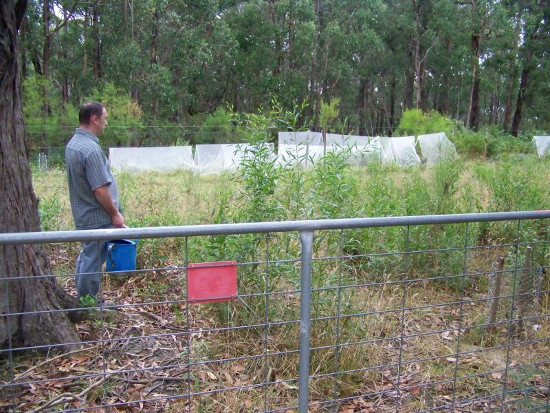Gardening Under Gums

Eucalyptus trees or as they are more commonly known, "gums" dominate most of the Australian landscape. We own a bush block (mainly messmate eucalypts) and enjoy the visiting koalas and other animals. But there's one thing we don't enjoy, and that is trying to grow a garden beneath our mature gum trees. So will we need to clearfell in order to grow our own veg? Fortunately there are a few things we can do, and we are already celebrating a successful raspberry patch.
Gardeners trying to establish a veggie patch under gums face a severe struggle. Most people think this is because the gum trees take all the available water leaving the veggies to die of thirst, no matter how often or how well you irrigate. But there are actually several reasons why it's difficult to garden under eucalyptus trees.
The first is the acidity. Acidity or alkalinity is measured in pH, with a pH of between 5.5 and 7.5 giving best results for growing veggies. We measured the pH in the runoff from a gum tree during a storm, with a result of 3.5 - well outside the Goldilocks range, which is why you'll often see barren soil within a close distance of the base of gum trees.
In addition, the oils in eucalyptus leaves, or phenols, are said to be "allelopathic". This means that they produce substances which inhibit the germination, growth, survival, and reproduction of other plants. Controlled experiments growing radishes from seed showed this effect to be possible, but minimal and possibly explained by the high acidity. Eucalyptus trees also grow tall, which blocks the available sunlight for other plants, and most vegetables ideally need at least six hours of sunlight per day.
Eucalypts do garner most of the available water, but not because of any special strength in their roots. Instead, gum trees make a profitable partnership with a so-called "fungal network" or "Wood Wide Web" which is an underground network created by mycorrhizal fungi which transfers water and nutrients around. Stronger plants have more to offer the network, and so get a priority deal for water.
One more problem with gardening under gums is that plants may be susceptible to fusarium wilt, and this seems to be especially the case on clay soil. Typically plants that are affected by fusarium wilt will develop yellowing leaves, and their older leaves are likely to fall off, showing all the symptoms of water stress and nitrogen deficiency even though neighbouring plants may be unaffected.
From all this, it seems gum trees create a lot of problems. But some benefits should be borne in mind too. A study has shown that the productivity and fertility of degraded sodic soils can be restored by gum tree plantation: https://tinyurl.com/lgq5twe
Also, at our place located on a hill, the gum trees prevent frost hitting the ground, creating a year-round frost free microclimate whilst five minutes down the road the community garden cannot grow frost tender plants such as pepinos, avocados or tamarillos. Our gum trees also provide filtered sunlight, which is a plus on 40 degree days.
It may be that you need to take out one or two gum trees to create enough of a break in the shade to grow your veggies. Apart from that, here are some ideas.
To give your veggie garden the best advantage against gum trees for water on the fungal network, try using raised beds rather than digging into the soil. Ideally, raised beds are a self-contained ecosystem which minimises loss of water and nutrients to the surrounding environment.
To ensure that your veggies stay healthy, don't overcommit your water resources to too many plants. Make certain that you can keep your veggies constantly moist so that there is plenty of water to go around on the fungal network (though not too wet) so that they can be healthy enough to fight off fusarium wilt.
Fusarium wilt seems to be common in eucalypt forest with clay soil. To combat fusarium wilt we are trialling Trichoderm, which is a parasitic fungi in the sense that it can consume other fungi. Trichoderm has been shown to combat fusarium wilt in a number of experiments. Trichoderm can also support plants' roots by providing water in exchange for sugars. Our main experiment this year will be to mix Trichoderm into our mulch and compost piles, so that wherever we improve the soil we also introduce Trichoderm. The other strategy is to dab small seedlings with Trichoderm spores when planting them out, as it is especially at the early seedling / transplanting stage that most plants can be susceptible to fusarium wilt.
Some plants do better than others under gum trees. Tagasaste or tree lucerne, while not a vegetable, is a very useful "chop and drop" tree (you can ruthlessly chop down branches to use as mulch in the same way you would use lucerne hay). Pepinos and cape gooseberries also show reasonable resistance to fusarium wilt, and where other tomatoes wither, we have found the Mortgage Lifter variety to produce a reasonable crop in the presence of fusarium wilt.
Plants that struggle with fusarium wilt include silver beet, broccoli, beans, sweet corn, capsicums, okra and melons.
If these ideas don't work, try using large self-watering pots such as Greensmart pots. These are still likely to get fusarium wilt from the abundant spores which come from the forest, but will stay moist if managed carefully, and can develop resistance over time.
Gum trees can cause a lot of problems for the home veggie grower, but they do provide shade in summer and shelter from frost in winter, and form an essential habitat for native animals. It should still be possible to have a productive garden without chopping all your eucalypts down.
